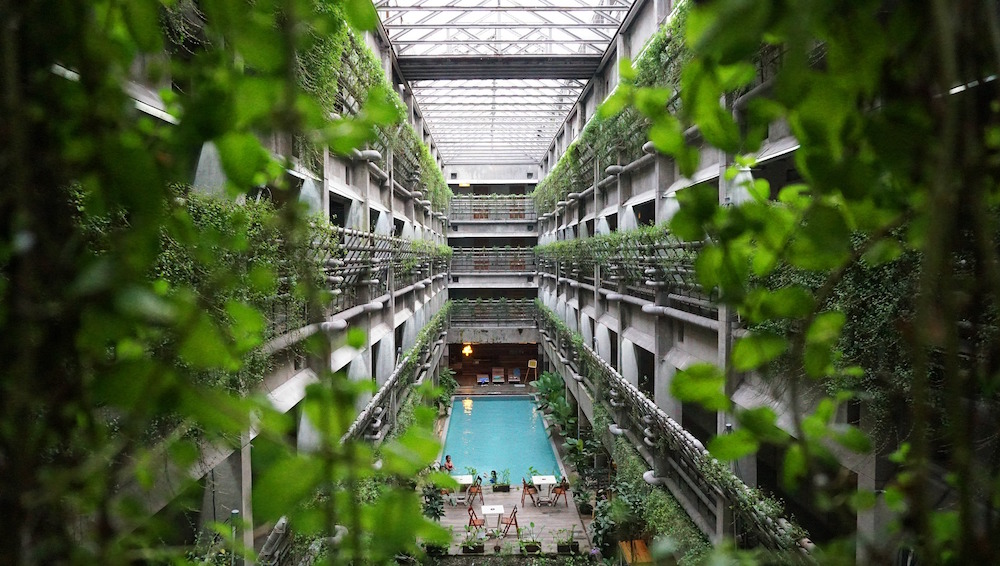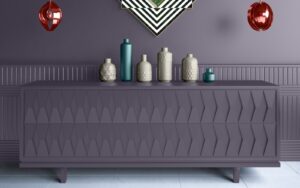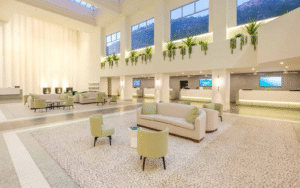For article three in the Hotel Designs LAB series, Hotel Designs and Arigami explore wellbeing through the lens of biophilic design. Founder of Arigami Ari Peralta and editor Hamish Kilburn compile the thoughts of biophilic design expert Oliver Heath and environmental psychology researcher Nigel Oseland to explore the science of nature in design…

Biophilic design is much more than adding plants to a space, it is a strategy for developing a multi-sensory relationship with the world around us. It is at the cross-section between the sustainability movement, wellness and human-centered design. It refers to the design practice of connecting people and nature within our built environments and communities.
The fundamental goal of biophilic design is to create a thriving habitat for people as biological organisms inhabiting modern structures. Regardless of your affinity for the word itself, we know that biophilic design works, and what we are proposing here are ways to create a shift in behaviour towards a more biophilic and sustainable future in Hospitality. Simply put, we need more ‘nature’ in our hotels. According to the latest research, the majority of our population now lives in urban environments and spends 90 per cent of their time indoors, with little access to nature. This isolation has led to increased mental and chronic physical health problems.
Biophilic design is a potential solution to some of these issues, however, its use in practice is still limited and widely misunderstood. Now more than ever, hotel guests are seeking spaces that are cleaner, calmer, and more restoring. In this article we will expand definitions and unfold the latest research supporting nature integration, enabling the industry to evolve its thinking from living walls to living hotels.
Helping us unfold the current practice of biophilic design and identifying barriers to implementation are biophilic designer Oliver Heath, and environmental psychologist and researcher Nigel Oseland. Each of them helped us shape our article with the aim of unlocking key actionable design insights.
Together we explored:
- Biomimetic Architecture
- Sustainability and Wellbeing
- Affective Response to Architecture
- Technobiophilia

Image credit: Pixabay
Biomimetic Architecture is on the rise
“For billions of years nature (animals, plants, and even microbes) has been solving many of the problems we are still dealing with today” says Nigel Oseland. Each has found what works, what is appropriate, and what lasts. Biomimicry and biomimetics come from the Greek words bios, meaning life, and mimesis, also meaning to imitate. We define biomimicry as the science and art of emulating nature’s best biological ideas to solve human problems. Oseland points out that biophilia is a broad term that also encompasses sound, temperature, ventilation and other environmental factors.
“Biophilia is much more than plants and greenery, it’s also about the diversity of furniture, sounds, temperature, materials and spaces that can support occupants every need.”
According to architect and designer Oliver Heath, Biomimetic architecture is now on the rise. Therefore, discovering its potential is vital. For designers, biology offers many valuable lessons. Think about it, nature develops a kind of ‘practical regionalism’, the belief that architecture should reflect the geography and culture of its setting. “The challenge is that research is relatively academic,” says Heath. “These studies whilst they peak one’s interest, it’s not enough. Our job is to translate the value of these findings to our customer”.
Now is the time to learn, experiment and prototype. Heath recommends starting with selecting a zone that can be measured against a comparable sample space. And look at the difference between them. When thinking like nature, the questions we must ask ourselves include:
- How would nature solve green building challenges?
- What are examples of nature’s solutions to these problems?
- What is the most energy efficient way of solving these problems?
- How does life make the most of things?
- How does life make things disappear into systems?
Humans have always looked to nature for inspiration to solve problems. Leonardo da Vinci even applied biomimicry to the study of birds in the hope of enabling human flight which later led to airplane design. Applied biomimicry can be utilised in three ways or in a combination of these three ways:
- Form – such as mimicking natural structures
- Processes – such as mimicking natural processes
- Systems – such as mimicking self-regulating ecosystems
Don’t forget that sustainability and wellbeing are measurable
We need to upgrade our buildings by upgrading our thinking. The importance of sustainability in the hospitality industry has come of age. What was initially considered by some as a checklist exercise has become a major design requirement. The potential environmental impact of hospitality projects is now central to the design and specification process. More recently, environmental considerations have focused on the impact that buildings have on the health and wellbeing of their guests.
Sustainable or Green design is an architectural movement that has gained a lot of momentum in recent years. It has been growing steadily since the turn of the century. Industry standards such as BREEAM, LEED and the WELL Building Standard are ways of making sure we consider these elements together, rather than in isolation. “Now we have to demonstrate the ROI related to a more human-centered approach”, added Heath.
While the main focus of sustainability is still largely on the environment, which includes making structures as energy and water efficient as possible. However, there has been a new branch of the green building movement that has gained traction as of late. This new sustainability trend is known as the healthy building movement.
It takes a holistic design approach that considers the construction of a building and its inhabitants as deeply intertwined. So in essence this new wave of wellbeing is intrinsically connected to our growing appreciation for sustainable initiatives. “With the rise in chronic illness, and mental health awareness also comes environmental awareness” says Oseland. We’ve ignored it for too long. Architects have always been conscious of this notion but there still remains a disconnect with engineering components and also with management. Oseland points out that we need to go back to a more natural way of approaching spaces and people.
From a design perspective, Heath mentioned that he faced initial resistance from clients wanting to adopt these ideas because he wasn’t speaking the language that was important to the client. “We had to shift from saying ‘saving the earth’, to ‘save your employees’, to ‘save yourself’,” concluded Heath.
Affective response to architecture is real
Architecture can inspire human behaviour in positive and negative ways such as the health and wellbeing of humans, as well as human performance. Oseland points out that our brain hasn’t caught up to our digital world. Thanks to evolutionary psychology we’ve learned about the sounds, views and parameters in which we function the best in. “Something as simple as daylight can make a significant difference on our circadian rhythms which can influence our hormones,” says Oseland. Because of this, the human mind and body function with improved efficiency when natural elements are present. Hotel guests tend to spend a large part of their hotel stay inside designed spaces whether it is in-room or lobby spaces, and less of their time in open-aired, natural environments which have a greater effect on guest behaviour.
Nature has powerfully engaged the mind with ‘involuntary fascination’, which helps restore directed attention and focus. According to Oseland, the result is an effortless mindfulness that promotes stress reduction and renewal while also stimulating curiosity and imagination. The benefits of biophilia span many sectors. Biophilic design optimises productivity, healing time, learning functions, and community cohesion as the perfect partnering mechanism for business vendors, hospital owners, school administrators, contractors, and city planners alike who are seeking to reap maximal value through development and design.
“Hotels need to evolve around measurement and validation. Learning is key to effective design.”
Integration of green architecture is something Heath has worked on for decades. He strongly believes that green hotel design cultivates a community of guests that are more aware and invested in a long-term shift toward generations that are healthier, more productive, and more connected to nature. According to Heath, the latest research clearly shows the benefits of biophilia include improved stress recovery rates, lower blood pressure, improved cognitive functions, enhanced mental stamina and focus, decreased violence and criminal activity, elevated moods, and increased learning rates.
For example, biophilic design’s emphasis on plant life has a direct impact on a building’s air quality. Plants are natural air purifiers, turning carbon dioxide into oxygen, so increasing the amount of plant life in an environment improves air quality. Another way biophilic design elements can impact air quality is through material choices. Using natural or environmentally friendly, biodegradable materials such as wood or bamboo prevent off-gassing, the release of chemicals from materials.

Image credit: Pixabay
Technobiophilia, an alternative to nature as we know it
There are many ways biophilic elements can be incorporated into a hotel space depending on the environment. Taking a virtual tour of a park or decorating guest rooms with digital plants can’t replace the health benefits of actually spending time outdoors. But when getting outside isn’t an option, experts say there are benefits to these alternatives. Technology is changing our relationship with nature as we know it.
Technological nature or ‘Technobiphilia’ has its benefits; engaging with it makes us feel good by triggering our innate ‘biophilia’. For example, researchers have found that nature videos played in hospitals drastically reduced pain amongst patients, suggesting nature’s relaxing influence translates through screens. Additional studies in healthcare have shown that people who have access to technological nature or organic design elements indoors experience less stress, improved mood and increased cognitive function.
“Biophilic design is much more than a single touch point in someone’s day. We have to think at a broader scale.”
Digital nature could also help with feelings of loneliness. A 2018 University of Washington study showed that university professors who worked in an office with a 50-inch plasma TV that depicted restorative nature scenes —serving, essentially, as a digital window— reported feeling connected to the outdoors and to the wider social community.
Everyone will have to try different approaches and seek what works best for them. People need to interact with actual nature. After 20 years of consulting and 10 years of research, Oseland has come to the conclusion that people are very different and that the only way to provide for them is by offering variety and choice.
What’s ahead?
“As designers we must ask ourselves how do we measure the value we bring to a client?”
The world of travel and hotel designs is fundamentally changing. What if we could experience the same physical, psychological, and emotional benefits moving through a hotel that we experience walking through a forest? What if we could right our relationship with nature by transforming the hospitality environment in a way that ensures buildings function in harmony with the natural world?
It can be very easy to think of hotel design in black and white terms; instead it is as colourful and multisensory as nature itself. Biophilic design helps people feel like they have spaces in which to settle, explore, adapt and be creative. These benefits build stronger connections and foster better collaboration, as well as trust in the ability to reinvigorate the industry. While our affinity for potted plants is a good start, it’s a mere gesture of what’s ahead for hospitality with exciting new initiatives in thermal, acoustics and circadian lighting design.
While you’re here, why not read our feature on safe design and guest emotional wellness?
Arigami is a research and innovation consultancy focused on wellbeing. We help our partners strategise, validate and measure wellbeing. We believe the industry must evolve, and with nimble research, we can maximise the impact of wellbeing strategies. It’s time to work together to transform hospitality into the leading industry combating anxiety and stress and improving the health of travellers globally.
Main image credit: Pixabay


























